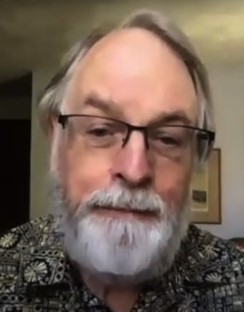M. Stanley Whittingham facts for kids
Quick facts for kids
Sir M. Stanley Whittingham
|
|
|---|---|

Whittingham in 2020
|
|
| Born |
Michael Stanley Whittingham
22 December 1941 Nottingham, England
|
| Nationality | British, American |
| Alma mater | New College, Oxford (BA, MA, DPhil) |
| Known for | Lithium-ion battery |
| Awards | Nobel Prize in Chemistry (2019) |
| Scientific career | |
| Fields | Chemist |
| Institutions | Binghamton University |
| Thesis | Microbalance studies of some oxide systems (1968) |
| Doctoral advisor | Peter Dickens |
| Other academic advisors | Robert Huggins (post-doc) |
Sir Michael Stanley Whittingham (born 22 December 1941) is a British-American chemist. He is a professor at Binghamton University in New York. He is famous for his important work on lithium-ion batteries. These batteries power many things we use every day. They are in mobile phones, laptops, and even electric cars.
In 2019, Sir Michael Whittingham won the Nobel Prize in Chemistry. He shared this award with Akira Yoshino and John B. Goodenough. They were recognized for developing lithium-ion batteries. Whittingham's early discoveries in the 1970s laid the groundwork for these batteries. He found a way to store energy using a process called intercalation. This process allows lithium ions to move in and out of materials. His ideas led to the first rechargeable lithium metal battery. Because of his pioneering work, he is often called the "founding father" of lithium-ion batteries.
Contents
Early Life and Education
Michael Stanley Whittingham was born in Nottingham, England. His birthday is on December 22, 1941. His father was an engineer, and his mother was a chemist.
He went to Stamford School from 1951 to 1960. After that, he studied chemistry at New College, Oxford University. He earned several degrees there, including his PhD in 1968. After finishing his studies, he moved to the United States. He worked at Stanford University for a while.
Career and Research
Sir Michael Whittingham spent many years working in industry. He worked for Exxon Research & Engineering Company for 16 years. He also worked for Schlumberger for four years. In 1988, he became a professor at Binghamton University. He teaches chemistry and materials science there.
From 1994 to 2000, he was in charge of research at Binghamton University. He also helped lead the Research Foundation of the State University of New York. He is now a Distinguished Professor at Binghamton.
Developing Lithium-Ion Batteries
Whittingham's most important work is on lithium-ion batteries. In the 1970s, he and his colleague Fred Gamble came up with the idea of an intercalation electrode. This was a key part of the first rechargeable lithium battery.
Exxon made Whittingham's first lithium-ion battery. It used a material called titanium disulfide and a lithium-aluminum part. This battery could store a lot of energy. It was also rechargeable because lithium ions could move easily in and out of the titanium disulfide.
Whittingham explained how these batteries work. He said, "It’s like putting jam in a sandwich." He meant that lithium ions go into a crystal structure. Then they can come out again, and the structure stays the same. This is why lithium batteries can be recharged many times.
Even though Exxon stopped their battery project due to safety worries, Whittingham kept publishing his research. His work helped other scientists continue to improve battery technology.
Advancing Battery Technology
Whittingham's research has continued to push battery technology forward. He is now working on ways to make batteries store even more energy. This involves using materials that can take in more than one lithium ion at a time. This could lead to batteries that last much longer.
His team at Binghamton University leads a center called NECCES. This center gets funding from the U.S. Department of Energy. They work to find new battery materials. Their goal is to make batteries cheaper, safer for the environment, and able to store more energy.
Awards and Recognition
Sir Michael Whittingham has received many awards for his groundbreaking work.
- In 1971, he received the Young Author Award from The Electrochemical Society.
- He was recognized as one of the Top 40 innovators in green technology in 2010.
- In 2012, he received the IBA Yeager Award for his lifetime contributions to lithium battery research.
- He was elected to the National Academy of Engineering in 2018. This was for his pioneering work on energy storage materials.
- In 2019, he won the Nobel Prize in Chemistry. He shared it with John B. Goodenough and Akira Yoshino. They were honored for developing lithium-ion batteries.
- In 2024, he was knighted by the King for his services to chemistry. This means he can now be called "Sir Michael."
Personal Life
Stanley Whittingham is married to Dr. Georgina Whittingham. She is also a professor. They have two children, Michael and Jenniffer.
Other Recognitions
- 2007 Chancellor's Award for Excellence in Scholarship and Creative Activities, State University of New York
- 2010 Award for Lifetime Contributions from the American Chemical Society
- 2015 Thomson Reuters Citation Laureate
- 2017 Senior Scientist Award from the International Society for Solid State Ionics
- 2018 Turnbull Award from the Materials Research Society
- 2020 Great Immigrants Award by the Carnegie Corporation of New York
- 2023 VinFuture Grand Prize
See also
 In Spanish: Stanley Whittingham para niños
In Spanish: Stanley Whittingham para niños

